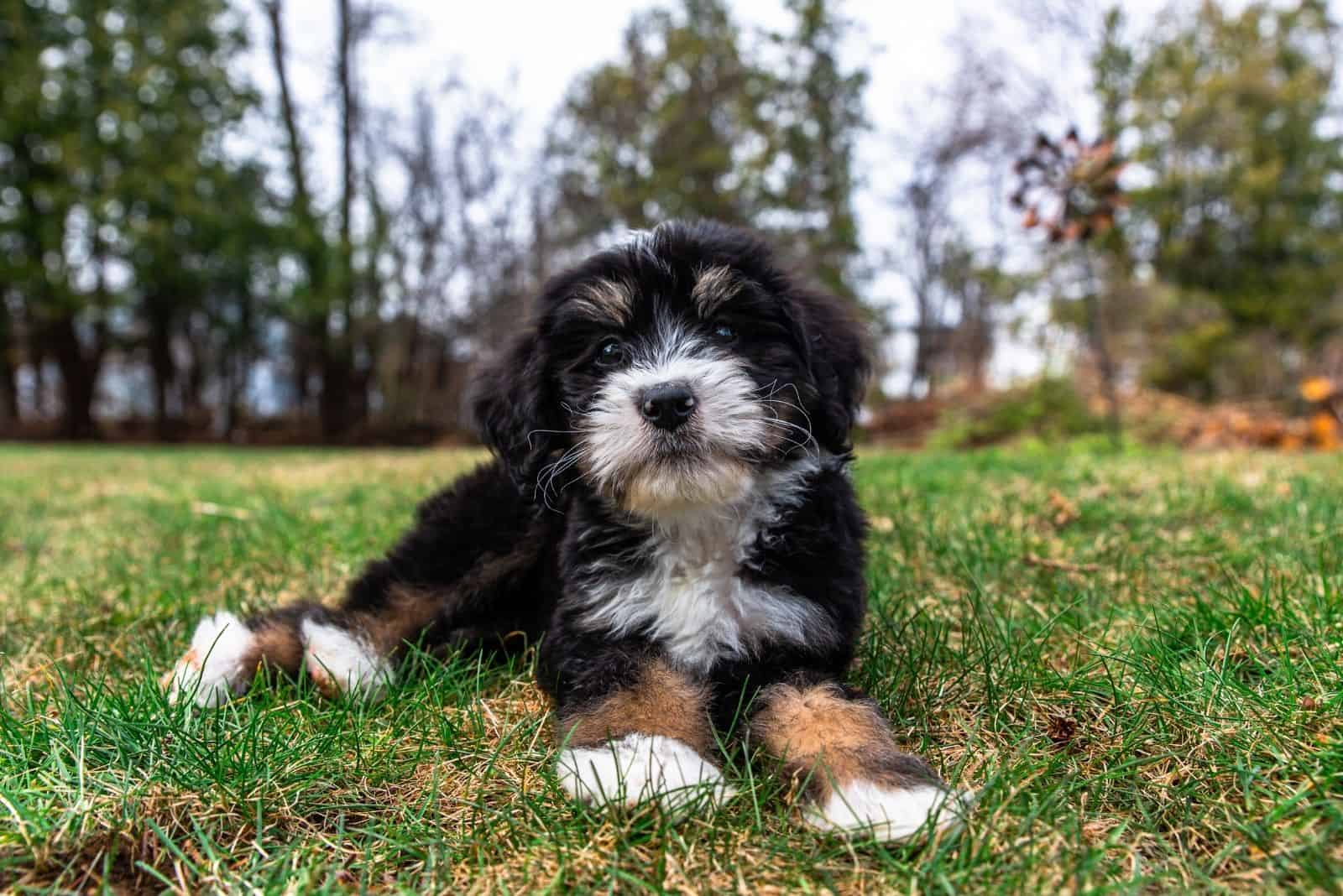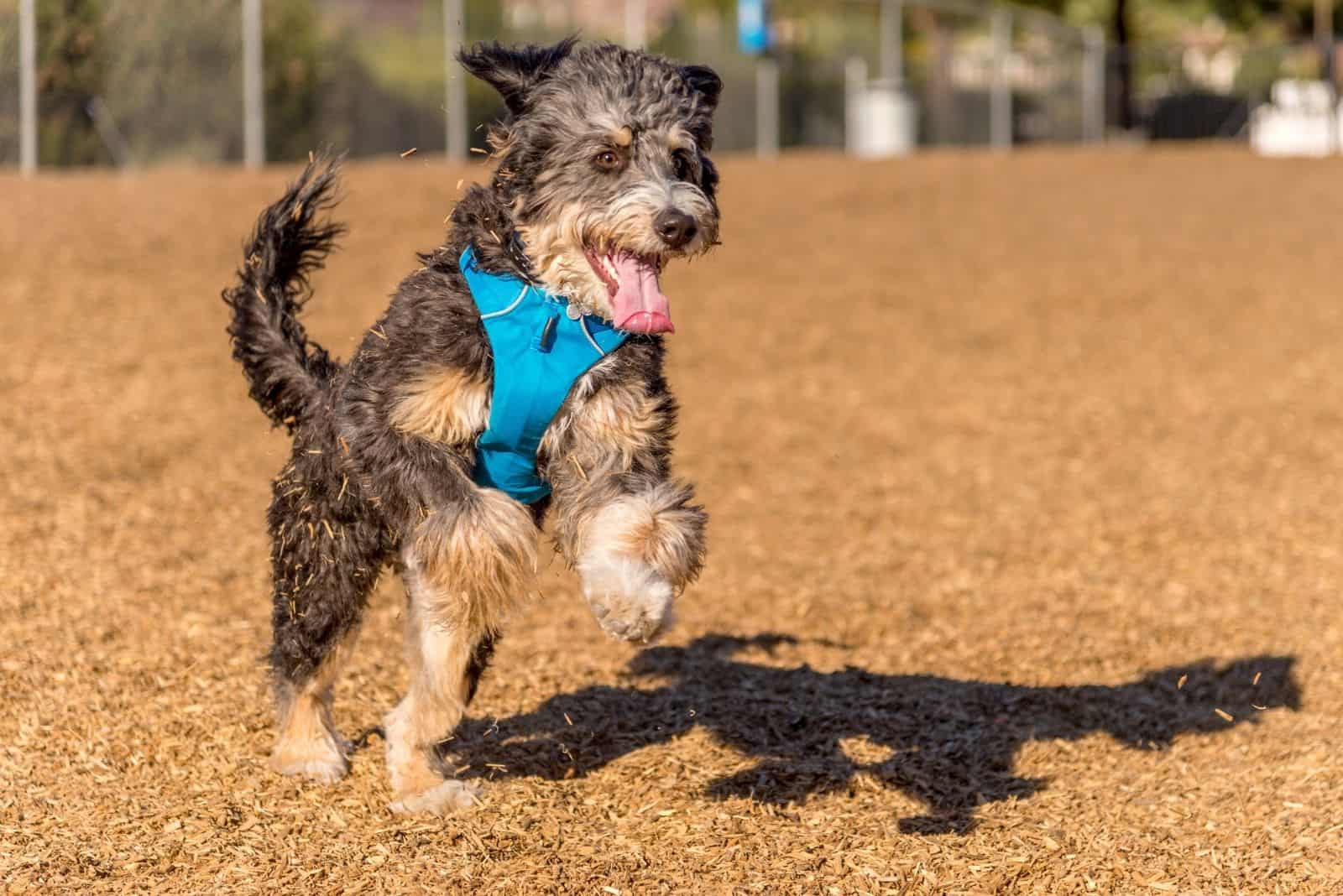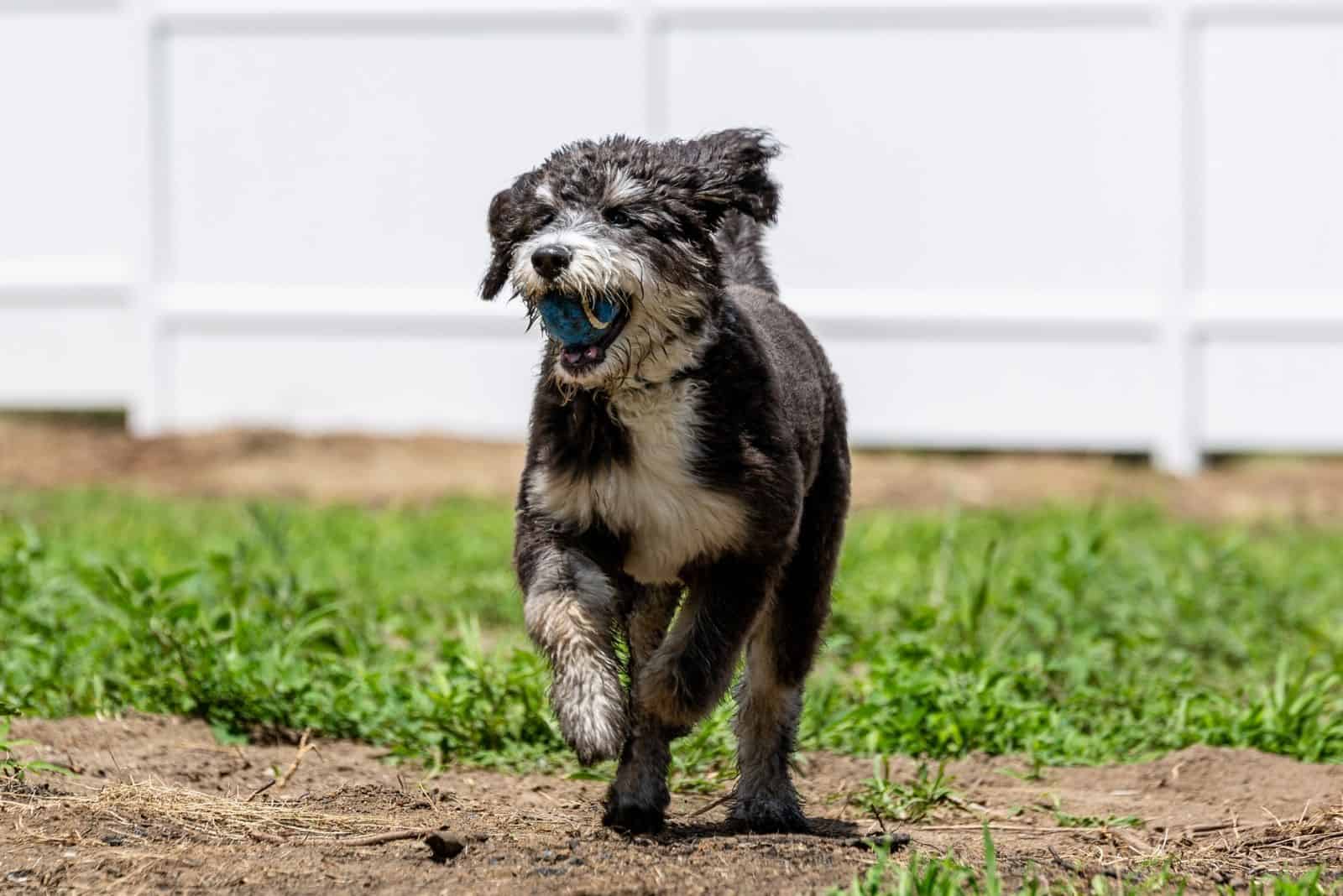Since their first appearance a few decades ago, it’s fair to say that ‘doodles’ of all breeds have captured the hearts of dog lovers worldwide.
Starting with the Labradoodle through to the Goldendoodle, these mixed breed ‘designer dogs’ have become firmly established as favorites everywhere.
One particular doodle-dog (which is a breed of dog crossed with a poodle, in case you didn’t know!) that has really melted hearts with its slightly goofy ‘teddy bear’ features is the Bernedoodle.
Anyone who has met or owned one of these loveable balls of fluff will understand why this is, but for those who aren’t familiar with this breed, here’s what you need to know.
What Is A Bernedoodle?

Mixed breeds, as everyone knows, have been around forever and are often created by accident.
This could be the case with the bernedoodle, although they were officially claimed as a breed by Sherry Rupke of Swissridge Kennels in 2003.
Sherry managed to cross a Bernese mountain dog with a standard poodle, seeking to combine the most favorable traits of both breeds.
She succeeded, creating a hybrid that immediately proved to be popular.
The name ‘bernedoodle’ is generally used, with the alternatives, ‘Bernese mountain poo’ and ‘bernepoo’ being (perhaps understandably!) rarer.
Although this hybrid is not recognized by the American Kennel Club (AKC), it is acknowledged by other organizations, such as the Designer Breed Registry and the American Canine Hybrid Club.
Even so, this mixed breed dog can occasionally be found in shelters, meaning that you don’t always have to approach a breeder to find your new pet.
One of the most appealing facts about bernedoodles is that they come in different sizes!
If a large dog doesn’t suit your needs and circumstances, but you admire their character, you might consider one of the smaller bernedoodle breeds.
There are three sizes to choose from:
• Standard Bernedoodle — 70 to 90 lbs and 23 to 29 inches (at the shoulder)
• Miniature Bernedoodle (or Mini/Toy Bernedoodle) — 25 to 50 lbs and 18 to 22 inches
• Tiny Bernedoodle — 10 to 24 lbs and 12 to 17 inches
This is achieved by breeding a Bernese mountain dog with one of three different poodle parents: standard poodle, toy poodle, or miniature poodle, resulting in three distinct sizes of dog, with all the loveable traits of both breeds.
What Are They Like?

Bernese mountain dogs were originally bred for ‘draft work’ (pulling carts) and herding on farms in the Swiss Alps, creating a breed that is hardy, strong, loyal, and alert. They are also known to be big softies and don’t take well to being scolded.
Poodles, on the other hand, are fun-loving, energetic, and highly-intelligent, originally bred for hunting.
When the two breeds are combined, the result is a fairly relaxed, super-loyal companion with bags of personality and intelligence, who will happily fit in with your family life, even when other dogs are already at home.
Of course, much of this will depend on the parent dogs. Some breeders will select a purebred ‘Berner’ and poodle, though others may use a bernedoodle and a poodle, or even two bernedoodles!
It’s always good to establish the parentage, as this could alert you to any potential health issues.
To find a 50/50 mix of both pure breeds, you need to look out for an f1 bernedoodle, which is a ‘first generation’ cross between a poodle and a Bernese mountain dog.
Due to the lack of consistency in breeding standards, appearances will vary greatly. Puppies can be any combination of white, black, brown, apricot, merle, sable, fawn, or cream, with a random scatter of color.
Occasionally, you’ll get ‘black tri-color’ pups, with the black/white/brown coat matching the pattern of the Bernese parent dog.
One piece of good news for allergy sufferers — bernedoodle coats are generally hypoallergenic!
Once again, this will depend on the parents, but as poodles are known for their ‘low-allergy’ coats, you can be sure that any effects will be minimal compared to other dog breeds.
Speaking of their coat, this can be curly, wavy, and even straight, though most tend to be long and wavy. As you’ll have guessed by now, this is down to the parent dogs.
The straight coat requires the most grooming, sheds more than the others, and will be the least hypoallergenic.
Please note: some people are allergic to dog saliva rather than hair/dander! You might want to consider seeking medical advice and have some tests beforehand.
The wavy coat is regarded as low-shed or non-shed, whereas the curly coat is the best option when it comes to a lack of shedding and its hypoallergenic qualities.
This coat is better for people with dog dander allergies.
Whichever type of coat your bernedoodle has, they will require regular brushing to avoid matting and to keep it in good condition.
Read Also: Bernedoodle Vs Sheepadoodle: Which Is The Better Dog Breed
Are There Any Health Issues?

Pure-breds are prone to many genetic diseases and conditions, whereas mixed breeds have a better chance of avoiding most of these.
However, they are by no means immune to health problems. Here’s a list of the most common ones:
• Skin issues — persistent scratching and licking can result in lesions on the skin that causes ‘hot spots’ (moist dermatitis). Treatment is needed to stop these from becoming infected, and the area needs to be protected against further aggravation.
• Bones — in dogs with a higher percentage of Bernese genes, there is an increased chance of bone problems, such as DJD (degenerative joint disease) and osteoarthritis.
• Hip dysplasia — this condition starts when they are pups, with either one or both hips forming abnormally, causing them a great deal of pain and eventually leading to arthritis.
• Elbow dysplasia — similar to the hip problem, but potentially more painful and problematic. The elbow joint relies on three bones working together perfectly. When bone or cartilage growth is mismatched, the joint doesn’t form correctly, causing pain and inflammation.
These are only a few of the conditions they may face, but regular health checks will help to reduce the risk of these or any other health problems becoming serious.
The average lifespan is between 12 to 18 years, with tiny bernedoodles being the longest-lived. There’s no reason why your own lovable pooch won’t live a long and healthy life, provided you give them the best chance.
How Do I Look After My Bernedoodle?

Every dog needs love and care, which goes without saying! But some breeds have specific requirements that help both them and you to get the most out of the relationship.
So, what does it take to look after your Berner/poodle crossbreed?
First, some of this will depend on the size of the dog you go for. Small to medium-sized dogs will usually fit well into apartment living and in more urban environments.
Though it is possible, of course, for large dogs to live in apartments in towns, it does present more of a challenge when it comes to living space and exercise.
Mental stimulation is as important as physical exercise. Although not an overly energetic dog, bernedoodles love to be outdoors (in all weather!) and can be very playful.
If you don’t keep them entertained, then they’ll seek this out for themselves.
This applies in the home, too. They love company and will stick by your side (and seek your attention, all the time), but they will fret and may become destructive if left alone.
Try to limit the time they are alone and always seek ways of keeping them occupied to relieve boredom.
This breed is considered perfect for family settings, and they get on especially well with kids (and other animals!).
However, early socialization is key to this, so start training your bernedoodle puppy as soon as you can. They can be slow learners, so you’ll need to be patient, and they’ll soon pick it up.
On the subject of training, although this is a playful and affectionate breed, children should also be trained in how to behave around all dogs and to treat them properly and with respect.
When it comes to feeding, this breed has a reputation for wolfing down whatever is placed before them. This can lead to obesity, which places extra pressure on the heart and bones.
It’s vital, then, to carefully monitor how much food you give them, as well as ensuring that it matches their lifestyle, size, and age.
It may seem obvious, but the quality of the food has a significant impact on their overall health.

Photo from:@totallydood_
However, when a dog eats anything and seems happy, there’s a temptation to keep feeding it the same thing, regardless of the lack of quality.
Finding the right amount of food can be tricky and takes a bit of trial and error. It’s always a good idea to keep a ‘weight diary’ to help you keep track of any changes.
To help you achieve the right balance, here’s a guide to feeding your bernedoodle, including things to avoid:
• Protein — The more active your dog, the more protein they will need. This will partly depend on your own lifestyle, so if you regularly enjoy a good hike (and bernedoodles will happily join you here!), then you may need good-quality high-protein dog food.
• Fat — Bernedoodle pups have seemingly boundless energy, so they can cope with higher fat levels. On the whole, though, adult dogs should have no more than 24% fat content in their diet. They can be greedy, so don’t be tempted to give in to their begging for more.
• Meat by-products — Some dog foods contain the ‘offal,’ all the bits that aren’t wanted! While they can be high in protein, they are considered low-quality and are often high in fatty tissue. Good quality dog food uses meat from the muscles, perhaps with a small percentage of ‘by-products.’
• Essential fatty acids — Often overlooked by dog food manufacturers, omega 3 and 6 are, as the name says, essential to your dog’s health. Omega 6 boosts the immune system, and omega 3 has anti-inflammatory qualities. Both are excellent for improving cognitive function and contributing to overall good health, particularly concerning the internal organs and skin.
• Kibble — Once again, go for a good quality one, such as a combination of brown/white rice, beef, dried yeast, oatmeal, barley, poultry, egg, and fishmeal (this provides the omega 3 & 6). It’s best to avoid foods with fillers such as corn, wheat, and soy, or those with artificial colors or preservatives.
• Wet food (canned) — When choosing canned dog foods, check the first handful of ingredients. This will immediately inform you of the quality! If there are fillers, such as soy, wheat, or meat by-products and artificial colors in the first five ingredients, then you’d be wise to place it back on the shelf. This is not the right food for your pooch.
While this is handy for ensuring that your full-grown bernedoodle gets all the nutrition they need, puppies require a little extra help.
Take some time to research foods that will boost their chances of a long and healthy life, helping them to develop properly, gain strength, and build their immune system.
Foods that contain peas, fruit, potatoes (including sweet potatoes), carrots, and lentils are a good choice.
The same can be said for those with supplements included, such as glucosamine, probiotics, and omega fatty acids.
On The Subject Of Puppies

At 8 weeks, these little bundles will face the trauma of leaving the mother and heading off to start life as a family dog. Bernedoodles, though ideally suited to this role, still need careful handling to help them settle in.
The journey home should be as stress-free as possible. Many dog owners know the trials of traveling with their pets and the perils of motion sickness.
In fact, most of the adverse reactions we see in dogs while traveling are down to anxiety rather than sickness.
Instead of packing that tiny, scared bundle away in a crate, have someone (not the driver!) hold them on their lap, wrapped in a towel or blanket.
If it’s a long journey, take plenty of rest breaks, but avoid places like service stations and truck stops that could harbor harmful bacteria — your new pup won’t have built up immunity to these just yet.
They should be weaned by now, so for the first few days, try to give them the same food to allow them to get used to it.
Spend as much time as you can with them while they are awake and keep them occupied with games and cuddles, as this makes them feel more comfortable and helps them settle in quickly.
One of the most important tasks is to get them checked out by your veterinarian at the earliest opportunity.
They will run a series of tests that will alert you to any problems, enabling you to take any necessary action.
You could also sort out any vaccinations (although most reputable breeders will already have taken care of this).
Having given them the best start, your precious pooch will thrive and grow to become a full-grown adult bernedoodle.
Look out for those telltale signs of hip or elbow dysplasia and seek medical advice immediately.
In a bernedoodle, you have the best of both worlds, whatever size you go for. The endearing qualities of the Berner and the poodle are concentrated into one big ball of fun.
They are ridiculously loyal, amiable, intelligent, and pretty energetic.
They may sulk if you scold them, but they’ll stick by you tirelessly.
Walk them daily, take them on a jog or a hike, through wind, rain, or shine. And they’ll reward you with all the love and affection you can handle.
What more could you ask from any dog?
















